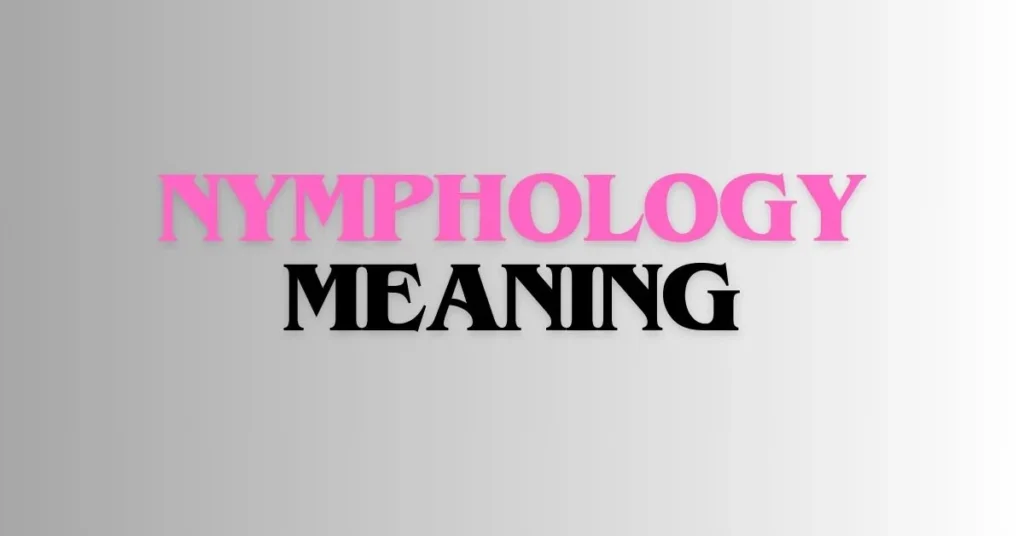Have you ever come across the term “nymphology” and wondered what it means? You’re not alone. Nymphology meaning isn’t widely known, but it’s a fascinating field that deserves more attention. Let’s dive into the captivating world of nymphology and uncover its secrets.
What Exactly is Nymphology?
Nymphology is the study of nymphs, not just in mythology but also in various cultural contexts. The term nymphology meaning encompasses a broad range of interpretations and applications. Nymphs, in classical mythology, are often depicted as beautiful maidens associated with nature. They are considered minor deities or spirits that reside in forests, rivers, mountains, and other natural settings.
The Mythological Roots of Nymphology:
The origins of nymphology trace back to ancient Greek and Roman myths. Nymphs were considered the daughters of Zeus and were known for their beauty and grace. These divine beings played significant roles in various myths and stories, often serving as symbols of fertility, nature, and the natural world.
In Greek mythology, nymphs were classified into different types based on their habitat. For example, Dryads were nymphs of the trees, Naiads were associated with water bodies, and Oreads were mountain nymphs. Each type had its own unique attributes and stories, contributing to the rich tapestry of mythological lore.
Nymphs in Different Cultures:
While nymphs are most commonly associated with Greek and Roman mythology, they appear in various forms across different cultures. In Slavic folklore, for instance, Rusalkas are water nymphs that inhabit lakes and rivers. These spirits are often depicted as beautiful maidens who can be both benevolent and malevolent.
Similarly, in Celtic mythology, there are tales of faeries and nature spirits that resemble nymphs. These beings are often connected to specific natural features, such as forests, springs, and groves. The study of nymphology, therefore, extends beyond classical mythology and delves into the diverse ways different cultures perceive and depict nature spirits.
Nymphs in Literature and Art:
Nymphs have inspired countless works of literature and art throughout history. From ancient poems to modern novels, these enchanting beings have captured the imagination of writers and artists alike. One of the most famous literary works featuring nymphs is Ovid’s “Metamorphoses,” which recounts numerous myths involving these ethereal creatures.
In visual art, nymphs have been a popular subject since ancient times. Paintings, sculptures, and frescoes often depict nymphs in idyllic natural settings, emphasizing their connection to the environment. The portrayal of nymphs in art highlights their symbolic role as embodiments of nature’s beauty and vitality.
The Symbolism of Nymphs:
Nymphs are rich in symbolism, representing various aspects of nature and human experience. They are often seen as symbols of fertility and growth, reflecting the cycles of life and the renewal of nature. Their association with natural elements like water, trees, and mountains underscores their role as protectors and personifications of the environment.
Moreover, nymphs can symbolize freedom and the untamed spirit of nature. Their wild and carefree nature embodies the idea of living in harmony with the natural world, free from societal constraints. This symbolism resonates with the modern desire to reconnect with nature and embrace a more sustainable way of living.
Modern Interpretations of Nymphology:
In contemporary times, the study of nymphs has evolved to encompass a broader range of interpretations. Modern nymphology explores not only the mythological and cultural aspects of nymphs but also their relevance in today’s world. This includes examining the ways nymphs are represented in popular culture, such as movies, television shows, and video games.
The resurgence of interest in mythology and folklore has led to a renewed fascination with nymphs. Many people are drawn to the idea of reconnecting with nature and exploring the mystical aspects of the natural world. Nymphology provides a unique lens through which to understand these interests and their cultural significance.
The Role of Nymphs in Environmentalism:
Given their deep connection to nature, nymphs can also be seen as symbols of environmentalism. The protection and preservation of natural habitats are central themes in many nymph myths. This makes nymphs powerful figures for advocating environmental awareness and conservation efforts.
By studying nymphology, we can gain insights into how ancient cultures understood and respected the natural world. This historical perspective can inform modern environmental practices and inspire us to develop a more harmonious relationship with nature.
Nymphology in Popular Culture:
Nymphs continue to captivate popular culture, appearing in various forms of media. From fantasy novels and movies to video games and music, nymphs are portrayed as enchanting and powerful beings. Their presence in popular culture highlights the enduring allure of these mythical creatures and their relevance in contemporary storytelling.
In films like “The Chronicles of Narnia” and “Percy Jackson & The Olympians,” nymphs play key roles, bringing a touch of magic and wonder to the stories. Video games like “The Witcher” series also feature nymphs, showcasing their mystical abilities and deep connection to nature.
The Future of Nymphology:
The future of nymphology meaning looks promising as interest in mythology and folklore continues to grow. Scholars and enthusiasts alike are exploring new ways to study and interpret nymphs, incorporating interdisciplinary approaches from fields like anthropology, literature, and environmental science.
As our understanding of nymphs evolves, so too does our appreciation for their cultural and ecological significance. Nymphology offers a rich and dynamic field of study that bridges the past and present, connecting ancient myths with modern concerns about nature and the environment.
How to Study Nymphology:
If you’re intrigued by the nymphology meaning and want to delve deeper into this fascinating field, there are several ways to get started. Reading classical myths and literature is a great way to gain a foundational understanding of nymphs and their roles in mythology. Books like Ovid’s “Metamorphoses” and Homer’s “The Odyssey” are excellent starting points.
Additionally, exploring academic articles and books on mythology and folklore can provide deeper insights into the cultural and symbolic significance of nymphs. Online courses and lectures on mythology and ancient history can also be valuable resources for aspiring nymphologists.
Conclusion: Embracing the Enchantment of Nymphology
Nymphology is a captivating field that offers a unique glimpse into the enchanting world of nymphs. From their mythological roots to their modern interpretations, nymphs continue to inspire and fascinate us. Understanding the nymphology meaning allows us to appreciate the rich cultural heritage of these mystical beings and their enduring relevance in today’s world.
As we navigate the complexities of modern life, the timeless allure of nymphs reminds us of the beauty and vitality of nature. By studying nymphology, we can foster a deeper connection to the natural world and embrace the enchantment that nymphs represent. So, whether you’re a mythology enthusiast or simply curious about these ethereal beings, nymphology offers a world of wonder waiting to be explored.







